Archaean Gold Mineralization in an Extensional Setting: The Structural History of the Kukuluma and Matandani Deposits, Geita Greenstone Belt, Tanzania
Abstract
:1. Introduction
2. Regional Geological Framework
2.1. The Geita Greenstone Belt (GGB)
2.2. Stratigraphy of the Kukuluma Terrain
3. The History of Deformation in the Kukuluma Terrain
3.1. D1 Normal Faulting and Bedding Parallel Shearing Events
3.2. D2–D3 Folding and Shearing
3.3. D4 Gentle Upright Folding
3.4. D5 Recumbent Folding and Low-Angle Reverse Faulting
3.5. D6 Brittle-Ductile Shear Zones
3.6. D7 Faulting
4. The Timing of Intrusions and Breccia Formation during Deformation
4.1. The Emplacement of Intrusions during Deformation
4.2. Syn-Tectonic Brecciation Events
5. Gold Mineralization
6. Discussion
6.1. Tectonic and Magmatic History of the Central Kukuluma Terrain
6.2. Controls on Gold Mineralization
7. Conclusions
Acknowledgments
Author Contributions
Conflicts of Interest
Appendix A. Fault Kinematic Analysis
References
- Goldfarb, R.J.; Groves, D.I.; Gardoll, S. Orogenic gold and geologic time: A global synthesis. Ore Geol. Rev. 2001, 18, 1–75. [Google Scholar] [CrossRef]
- Goldfarb, R.J.; Baker, T.; Dube, B.; Groves, D.; Hart, C.; Gosslein, P. Distribution, character and genesis of gold deposits in metamorphic terranes. In Economic Geology One Hundredth Anniversary Volume; Society of Economic Geologists, Inc.: Littleton, CO, USA, 2005; pp. 407–450. [Google Scholar]
- Groves, D.I.; Vielreicher, R.M.; Goldfarb, R.J.; Condie, K.C. Controls on the heterogeneous distribution of mineral deposits through time. Geol. Soc. Lond. Spec. Publ. 2005, 248, 71–101. [Google Scholar] [CrossRef]
- Laznicka, P. Giant metallic deposits—A century of progress. Ore Geol. Rev. 2014, 62, 259–314. [Google Scholar] [CrossRef]
- Groves, D.I.; Goldfarb, R.J.; Gebre-Mariam, M.; Hagemann, S.G.; Robert, F. Orogenic gold deposits: A proposed classification in the context of their crustal distribution and relationship to other gold deposit types. Ore Geol. Rev. 1998, 13, 7–27. [Google Scholar] [CrossRef]
- Bierlein, F.P.; Groves, D.I.; Cawood, P.A. Metallogeny of accretionary orogens—The connection between lithospheric processes and metal endowment. Ore Geol. Rev. 2009, 36, 282–292. [Google Scholar] [CrossRef]
- Bierlein, F.P.; Groves, D.I.; Goldfarb, R.J.; Dubé, B. Lithospheric controls on the formation of provinces hosting giant orogenic gold deposits. Miner. Depos. 2006, 40, 874–886. [Google Scholar] [CrossRef]
- Goldfarb, R.J.; Groves, D.I. Orogenic gold: Common or evolving fluid and metal sources through time. Lithos 2015, 233, 2–26. [Google Scholar] [CrossRef]
- Groves, D.I.; Santosh, M.; Goldfarb, R.J.; Zhang, L. Structural geometry of orogenic gold deposits: Implications for exploration of world-class and giant deposits. Geosci. Front. 2018. [CrossRef]
- Kabete, J.M.; Groves, D.I.; McNaughton, N.J.; Mruma, A.H. A new tectonic and temporal framework for the tanzanian shield: Implications for gold metallogeny and undiscovered endowment. Ore Geol. Rev. 2012, 48, 88–124. [Google Scholar] [CrossRef]
- Sanislav, I.V.; Kolling, S.L.; Brayshaw, M.; Cook, Y.A.; Dirks, P.H.G.M.; Blenkinsop, T.G.; Mturi, M.I.; Ruhega, R. The geology of the giant Nyankanga gold deposit, Geita Greenstone Belt, Tanzania. Ore Geol. Rev. 2015, 69, 1–16. [Google Scholar] [CrossRef]
- Frimmel, H.E. Earth’s continental crustal gold endowment. Earth Planet. Sci. Lett. 2008, 267, 45–55. [Google Scholar] [CrossRef]
- Sibson, R.H. Controls on maximum fluid overpressure defining conditions for mesozonal mineralisation. J. Struct. Geol. 2004, 26, 1127–1136. [Google Scholar] [CrossRef]
- Cox, S.F. Coupling between deformation, fluid pressures, and fluid flow in ore-producing hydrothermal systems at depth in the crust. In One Hundredth Anniversary Volume; Hedenquist, J.W., Thompson, J.F.H., Goldfarb, R.J., Richards, J.P., Eds.; Society of Economic Geologists: Littleton, CO, USA, 2005. [Google Scholar]
- Robert, F.; Poulsen, K.H.; Cassidy, K.F.; Hodgson, C.J. Gold metallogeny of the Superior and Yilgarn Cratons. In One Hundredth Anniversary Volume; Hedenquist, J.W., Thompson, J.F.H., Goldfarb, R.J., Richards, J.P., Eds.; Society of Economic Geologists: Littleton, CO, USA, 2005. [Google Scholar]
- Bateman, R.; Hagemann, S. Gold mineralisation throughout about 45 MA of Archaean orogenesis: Protracted flux of gold in the Golden Mile, Yilgarn Craton, Western Australia. Miner. Depos. 2004, 39, 536–559. [Google Scholar] [CrossRef]
- Blewett, R.S.; Henson, P.A.; Roy, I.G.; Champion, D.C.; Cassidy, K.F. Scale-integrated architecture of a world-class gold mineral system: The Archaean Eastern Yilgarn Craton, Western Australia. Precambrian Res. 2010, 183, 230–250. [Google Scholar] [CrossRef]
- Baker, T.; Bertelli, M.; Blenkinsop, T.; Cleverley, J.S.; McLellan, J.; Nugus, M.; Gillen, D. P-T-X conditions of fluids in the Sunrise Dam gold deposit, Western Australia, and implications for the interplay between deformation and fluids. Econ. Geol. 2010, 105, 873–894. [Google Scholar] [CrossRef]
- Jones, S. Contrasting structural styles of gold deposits in the leonora domain: Evidence for early gold deposition, eastern goldfields, western australia. Aust. J. Earth Sci. 2014, 61, 881–917. [Google Scholar] [CrossRef]
- Dirks, P.H.G.M.; Charlesworth, E.G.; Munyai, M.R.; Wormald, R. Stress analysis, post-orogenic extension and 3.01GA gold mineralisation in the Barberton Greenstone Belt, South Africa. Precambrian Res. 2013, 226, 157–184. [Google Scholar]
- Bédard, J.H.; Brouillette, P.; Madore, L.; Berclaz, A. Archaean cratonization and deformation in the northern Superior Province, Canada: An evaluation of plate tectonic versus vertical tectonic models. Precambrian Res. 2003, 127, 61–87. [Google Scholar] [CrossRef]
- Bédard, J.H. A catalytic delamination-driven model for coupled genesis of archaean crust and sub-continental lithospheric mantle. Geochimica et Cosmochimica Acta 2006, 70, 1188–1214. [Google Scholar] [CrossRef]
- Hamilton, W.B. Plate tectonics began in neoproterozoic time, and plumes from deep mantle have never operated. Lithos 2011, 123, 1–20. [Google Scholar] [CrossRef]
- Van Kranendonk, M.J. Cool greenstone drips and the role of partial convective overturn in Barberton greenstone belt evolution. J. Afr. Earth Sci. 2011, 60, 346–352. [Google Scholar] [CrossRef]
- Borg, G. The geita gold deposit, NW-Tanzania. Geology, ore petrology, geochemistry and timing of events. Geol. Jahrb. D 1994, D100, 545–595. [Google Scholar]
- Sanislav, I.V.; Brayshaw, M.; Kolling, S.L.; Dirks, P.H.G.M.; Cook, Y.A.; Blenkinsop, T.G. The structural history and mineralization controls of the world-class Geita Hill gold deposit, Geita Greenstone Belt, Tanzania. Miner. Depos. 2017, 52, 257–279. [Google Scholar] [CrossRef]
- Kwelwa, S.D.; Sanislav, I.V.; Dirks, P.H.G.M.; Blenkinsop, T.; Kolling, S.L. The petrogenesis of the Neoarchean Kukuluma Intrusive Complex, NW Tanzania. Precambrian Res. 2018, 305, 64–78. [Google Scholar] [CrossRef]
- Kwelwa, S.D.; Sanislav, I.V.; Dirks, P.H.G.M.; Blenkinsop, T.; Kolling, S.L. Zircon U-Pb ages and Hf isotope data from the Kukuluma Terrain of the Geita Greenstone Belt, Tanzania Craton: Implications for stratigraphy, crustal growth and timing of gold mineralization. J. Afr. Earth Sci. 2018, 139, 38–54. [Google Scholar] [CrossRef]
- Sanislav, I.V.; Dirks, P.H.G.M.; Blenkinsop, T.; Kolling, S.L. The tectonic history of a crustal-scale shear zone in the tanzania craton from the Geita Greenstone Belt, NW-Tanzania Craton. Precambrian Res. 2018, 310, 1–16. [Google Scholar] [CrossRef]
- Sanislav, I.V.; Wormald, R.J.; Dirks, P.H.G.M.; Blenkinsop, T.G.; Salamba, L.; Joseph, D. Zircon U–Pb ages and Lu–Hf isotope systematics from late-tectonic granites, Geita Greenstone Belt: Implications for crustal growth of the Tanzania Craton. Precambrian Res. 2014, 242, 187–204. [Google Scholar] [CrossRef]
- Gabert, G. Lithostratigraphic and tectonic setting of gold mineralization in the Archean Cratons of Tanzania and Uganda, East Africa. Precambrian Res. 1990, 46, 59–69. [Google Scholar] [CrossRef]
- Kuehn, S.; Ogola, J.; Sango, P. Regional setting and nature of gold mineralization in Tanzania and southwest Kenya. Precambrian Res. 1990, 46, 71–82. [Google Scholar] [CrossRef]
- Borg, G. New aspects of the lithostratigraphy and evolution of the Siga Hills, an Archaean Granite-Greenstone Terrain in NW Tanzania. Zeitschrift fur Angewandte Geologie 1992, 38, 89–93. [Google Scholar]
- Borg, G.; Shackleton, R.M. The Tanzania and Ne-Zaire Cratons; Oxford University Press: Oxford, UK, 1997. [Google Scholar]
- Borg, G.; Krogh, T. Isotopic age data of single zircons from the Archaean Sukumaland Greenstone Belt, Tanzania. J. Afr. Earth Sci. 1999, 29, 301–312. [Google Scholar] [CrossRef]
- Manya, S.; Maboko, M.A.H. Geochemistry of the neoarchaean mafic volcanic rocks of the geita area, NW Tanzania: Implications for stratigraphical relationships in the Sukumaland greenstone belt. J. Afr. Earth Sci. 2008, 52, 152–160. [Google Scholar] [CrossRef]
- Cook, Y.A.; Sanislav, I.V.; Hammerli, J.; Blenkinsop, T.G.; Dirks, P.H.G.M. A primitive mantle source for the Neoarchean mafic rocks from the Tanzania Craton. Geosci. Front. 2016, 7, 911–926. [Google Scholar] [CrossRef]
- Kabete, J.M.; McNaughton, N.J.; Groves, D.I.; Mruma, A.H. Reconnaissance shrimp U–Pb zircon geochronology of the Tanzania Craton: Evidence for Neoarchean granitoid–greenstone belts in the central Tanzania Region and the Southern East African Orogen. Precambrian Res. 2012, 216–219, 232–266. [Google Scholar] [CrossRef]
- Sanislav, I.V.; Blenkinsop, T.G.; Dirks, P.H.G.M. Archean crustal growth through successive partial melting events in an oceanic plateau-like setting in the Tanzania Craton. Terra Nova 2018, 1–10. [Google Scholar] [CrossRef]
- Manya, S. Petrogenesis and emplacement of the TTG and K-rich granites at the Buzwagi gold mine, northern Tanzania: Implications for the timing of gold mineralization. Lithos 2016, 256–257, 26–40. [Google Scholar] [CrossRef]
- Borg, G.; Lyatuu, D.R.; Rammlmair, D. Genetic aspects of the Geita and Jubilee Reef Archean BIF-hosted gold deposits, Tanzania. Geologische Rundschau 1990, 79, 355–371. [Google Scholar] [CrossRef]
- Skead, M.B.; Chuwa, G. Geita West Deposit—Geological and Mineralization Model; Internal AngloGold Report; Geita Gold Mine—Exploration Departmen: Geita, Tanzania, 2003; p. 26. [Google Scholar]
- Painter, M. Mineralisation and Structural Architecture of the Geita Hill Shear Zone; Internal AngloGold Report; Geita Gold Mine: Geita, Tanzania, 2004; p. 26. [Google Scholar]
- Hofmann, A.; Dirks, P.H.G.M.; Jelsma, H.A. Late Archaean foreland basin deposits, Belingwe greenstone belt, Zimbabwe. Sediment. Geol. 2001, 141–142, 131–168. [Google Scholar] [CrossRef]
- Thiessen, R. Two-dimensional refold interference patterns. J. Struct. Geol. 1986, 8, 563–573. [Google Scholar] [CrossRef]
- Fossen, H. Structural Geology; Cambridge University Press: Cambridge, UK, 2010. [Google Scholar]
- Bansah, D.; Chase, R.; Davidson, A.; Michael, H.; Skead, M. The Geita and Kukuluma mineralized trends, Lake Victoria Goldfield, Tanzania—Ore body characteristics and project planning. In Proceedings of the 4th International Mining Geology Conference, Coolum, Queensland, Australia, 14–17 May 2000; pp. 115–127. [Google Scholar]
- Skead, M.B. Geology and Structure of the Kukuluma Deposit, Geita Greenstone Belt, Tanzania; Internal AngloGold Report; Geita Gold Mine: Geita, Tanzania, 2003; p. 27. [Google Scholar]
- Marrett, R.; Allmendinger, R.W. Kinematic analysis of fault-slip data. J. Struct. Geol. 1990, 12, 973–986. [Google Scholar] [CrossRef]
- Allmendinger, R.W.; Cardozo, N.; Fisher, D.M. Structural Geology Algorithms: Vectors and Tensors; Cambridge University Press: Cambridge, UK; New York, NY, USA, 2012. [Google Scholar]
- Vlaar, N.J.; van Keken, P.E.; van den Berg, A.P. Cooling of the earth in the Archaean: Consequences of pressure-release melting in a hotter mantle. Earth Planet. Sci. Lett. 1994, 121, 1–18. [Google Scholar] [CrossRef]
- Champion, D.C.; Smithies, R.H. Chapter 4.3 Geochemistry of Paleoarchean Granites of the East Pilbara Terrane, Pilbara Craton, Western Australia: Implications for Early Archean Crustal Growth. In Developments in Precambrian Geology; van Kranendonk, M.J., Smithies, R.H., Bennett, V.C., Eds.; Elsevier: New York, NY, USA, 2007; Volume 15, pp. 369–409. [Google Scholar]
- Smithies, R.H.; Champion, D.C.; Van Kranendonk, M.J. Formation of paleoarchean continental crust through infracrustal melting of enriched basalt. Earth Planet. Sci. Lett. 2009, 281, 298–306. [Google Scholar] [CrossRef]
- Van Kranendonk, M. Two types of Archean continental crust: Plume and plate tectonics on early Earth. Am. J. Sci. 2010, 310, 1187–1209. [Google Scholar] [CrossRef]
- Jelsma, H.A.; Vinyu, M.L.; Wijbrans, J.R.; Verdurmen, E.A.T.; Valbracht, P.J.; Davies, G.R.; Valbracht, P.J. Constraints on Archaean crustal evolution of the Zimbabwe Craton: A U-Pb zircon, Sm-Nd and Pb-Pb whole-rock isotope study. Contrib. Mineral. Petrol. 1996, 124, 55–70. [Google Scholar] [CrossRef]
- Lin, S.; Beakhouse, G.P. Synchronous vertical and horizontal tectonism at late stages of Archean cratonization and genesis of Hemlo gold deposit, Superior Craton, Ontario, Canada. Geology 2013, 41, 359–362. [Google Scholar] [CrossRef]
- Sanislav, I.V. Porphyroblast rotation and strain localization: Debate settled!: Comment. Geology 2010, 38, e204. [Google Scholar] [CrossRef]
- Dirks, P.H.G.M.; Jelsma, H.A.; Hofmann, A. Thrust-related accretion of an Archaean greenstone belt in the midlands of Zimbabwe. J. Struct. Geol. 2002, 24, 1707–1727. [Google Scholar] [CrossRef]
- Cox, S.; Knackstedt, M.; Braun, J. Principles of structural control on permeability and fluid flow in hydrothermal systems. Rev. Econ. Geol. 2001, 14, 1–24. [Google Scholar]
- Porter, C. Structural Analysis and Target Generation, Kukuluma-Matandani Area, Geita Greenstone Belt, Tanzania; Internal AngloGold Report; Geita Gold Mine: Geita, Tanzania, 2002; p. 24. [Google Scholar]
- Schultz, R.A.; Fossen, H. Displacement–length scaling in three dimensions: The importance of aspect ratio and application to deformation bands. J. Struct. Geol. 2002, 24, 1389–1411. [Google Scholar] [CrossRef]
- Schultz, R.A.; Okubo, C.H.; Wilkins, S.J. Displacement-length scaling relations for faults on the terrestrial planets. J. Struct. Geol. 2006, 28, 2182–2193. [Google Scholar] [CrossRef]
- Ridley, J. The relations between mean rock stress and fluid flow in the crust: With reference to vein- and lode-style gold deposits. Ore Geol. Rev. 1993, 8, 23–37. [Google Scholar] [CrossRef]
- Schultz, R.A.; Soliva, R.; Fossen, H.; Okubo, C.H.; Reeves, D.M. Dependence of displacement–length scaling relations for fractures and deformation bands on the volumetric changes across them. J. Struct. Geol. 2008, 30, 1405–1411. [Google Scholar] [CrossRef]
- Weinberg, R.F.; van der Borgh, P. Extension and gold mineralization in the Archean Kalgoorlie Terrane, Yilgarn Craton. Precambrian Res. 2008, 161, 77–88. [Google Scholar] [CrossRef]
- Dirks, P.H.G.M.; Charlesworth, E.G.; Munyai, M.R. Cratonic extension and archaean gold mineralisation in the Sheba-Fairview Mine, Barberton Greenstone Belt, South Africa. S. Afr. J. Geol. 2009, 112, 291–316. [Google Scholar] [CrossRef]
- Seward, T.M. The hydrothermal geochemistry of gold. In Gold Metallogeny and Exploration; Springer: New York, NY, USA, 1991; pp. 37–62. [Google Scholar]
- Seward, T.M. Thio complexes of gold and the transport of gold in hydrothermal ore solutions. Geochimica et Cosmochimica Acta 1973, 37, 379–399. [Google Scholar] [CrossRef]
- Kerrich, R.; Goldfarb, R.; Groves, D.; Garwin, S. The geodynamics of world-class gold deposits: Characteristics, space-time distribution, and origins. In Gold in 2000; Society of Economic Geologists, Inc.: Littleton, CO, USA, 2000; Volume 13, pp. 501–551. [Google Scholar]
- Campbell McCuaig, T.; Kerrich, R. P—T—t—deformation—fluid characteristics of lode gold deposits: Evidence from alteration systematics. Ore Geol. Rev. 1998, 12, 381–453. [Google Scholar] [CrossRef]
- Likhoidov, G.G.; Plyusnina, L.P.; Shcheka, Z.A. The behavior of gold during listvenitization: Experimental and theoretical simulation. Dokl. Earth Sci. 2007, 415, 723–726. [Google Scholar] [CrossRef]
- Chamberlain, C.M. Geology and Genesis of the Bulyanhulu Gold Deposit, Sukumaland Greenstone Belt, Tanzania. Unpublished Ph.D. Thesis, Imperial College, London, UK, 2003; p. 410. [Google Scholar]
- Chamberlain, C.M.; Tosdal, R.M. U–Pb Geochronology of the Lake Victoria Greenstone Terrane, Tanzania; Anglo-Gold Ashanti internal report; Mineral Deposit Research Unit, The University of British Columbia: Vancouver, BC, Canada, 2007; p. 43. [Google Scholar]
- Vos, I.M.A.; Bierlein, F.P.; Standing, J.S.; Davidson, G. The geology and mineralisation at the golden pride gold deposit, Nzega Greenstone Belt, Tanzania. Miner. Depos. 2009, 44, 751. [Google Scholar] [CrossRef]
- Angelier, J.; Mechler, P. Sur une méthode graphique de recherche des contraintes principales également utilisable en tectonique et en séismologie: La méthode des dièdres droits. Bulletin de la Société Géologique de France 1977, 7, 1309–1318. [Google Scholar] [CrossRef]
- Delvaux, D.; Sperner, B. New aspects of tectonic stress inversion with reference to the tensor programme. Geol. Soc. Lond. Spec. Publ. 2003, 212, 75–100. [Google Scholar] [CrossRef]
- Angelier, J. Fault slip analysis and palaeostress reconstruction. In Continental Deformation; Hancock, P.L., Ed.; Pergamon: Oxford, UK, 1994; pp. 101–120. [Google Scholar]
- Etchecopar, A.; Vasseur, G.; Daignieres, M. An inverse problem in microtectonics for the determination of stress tensors from fault striation analysis. J. Struct. Geol. 1981, 3, 51–65. [Google Scholar] [CrossRef]
- Lisle, R.J. Principal stress orientations from faults: An additional constraint. Ann. Tecton. 1987, 1, 155–158. [Google Scholar]
- Allmendinger, R.W. Faultkinwin, Version 1.1: A Program for Analyzing Fault Slip Data for Windows™. 2001. Available online: https://www.scienceopen.com/document?vid=d520a2b8-1b84-41f7-b341-8479edd4eb19 (accessed on 21 April 2018).
- Cladouhos, T.T.; Allmendinger, R.W. Finite strain and rotation from fault slip data. J. Struct. Geol. 1993, 15, 771–784. [Google Scholar] [CrossRef]
- Molnar, P. Average regional strain due to slip on numerous faults of different orientations. J. Geophys. Res. 1983, 88, 6430–6432. [Google Scholar] [CrossRef]
- Twiss, R.J.; Unruh, J.R. Analysis of fault slip inversions: Do they constrain stress or strain rate? J. Geophys. Res. 1998, 101, 8335–8361. [Google Scholar] [CrossRef]
- Sperner, B.; Müller, B.; Heidbach, O.; Delvaux, D.; Reinecker, J.; Fuchs, K. Tectonic stress in the Earth’s crust: Advances in the world stress map project. Geol. Soc. Lond. Spec. Publ. 2003, 212, 101–116. [Google Scholar] [CrossRef]
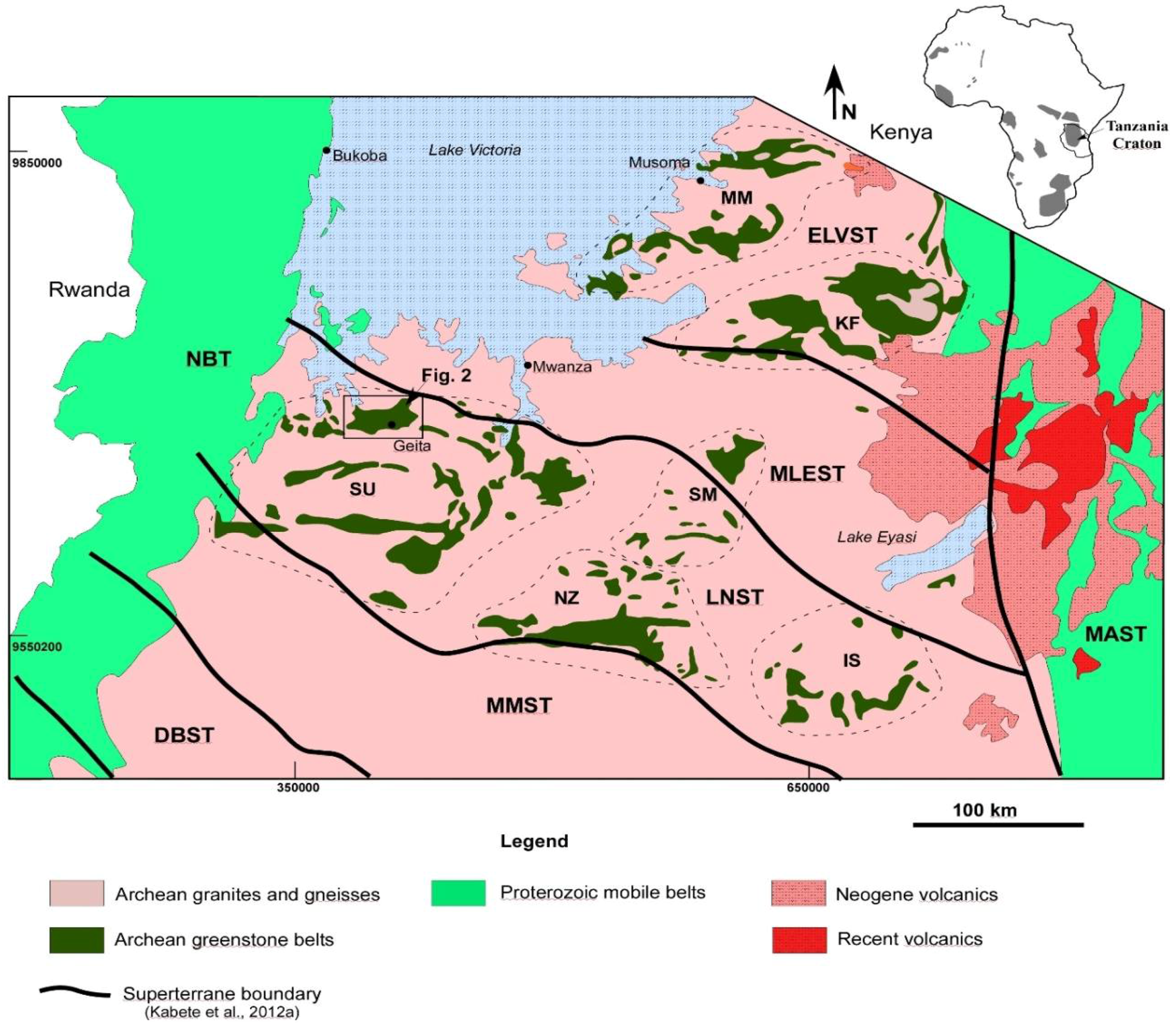
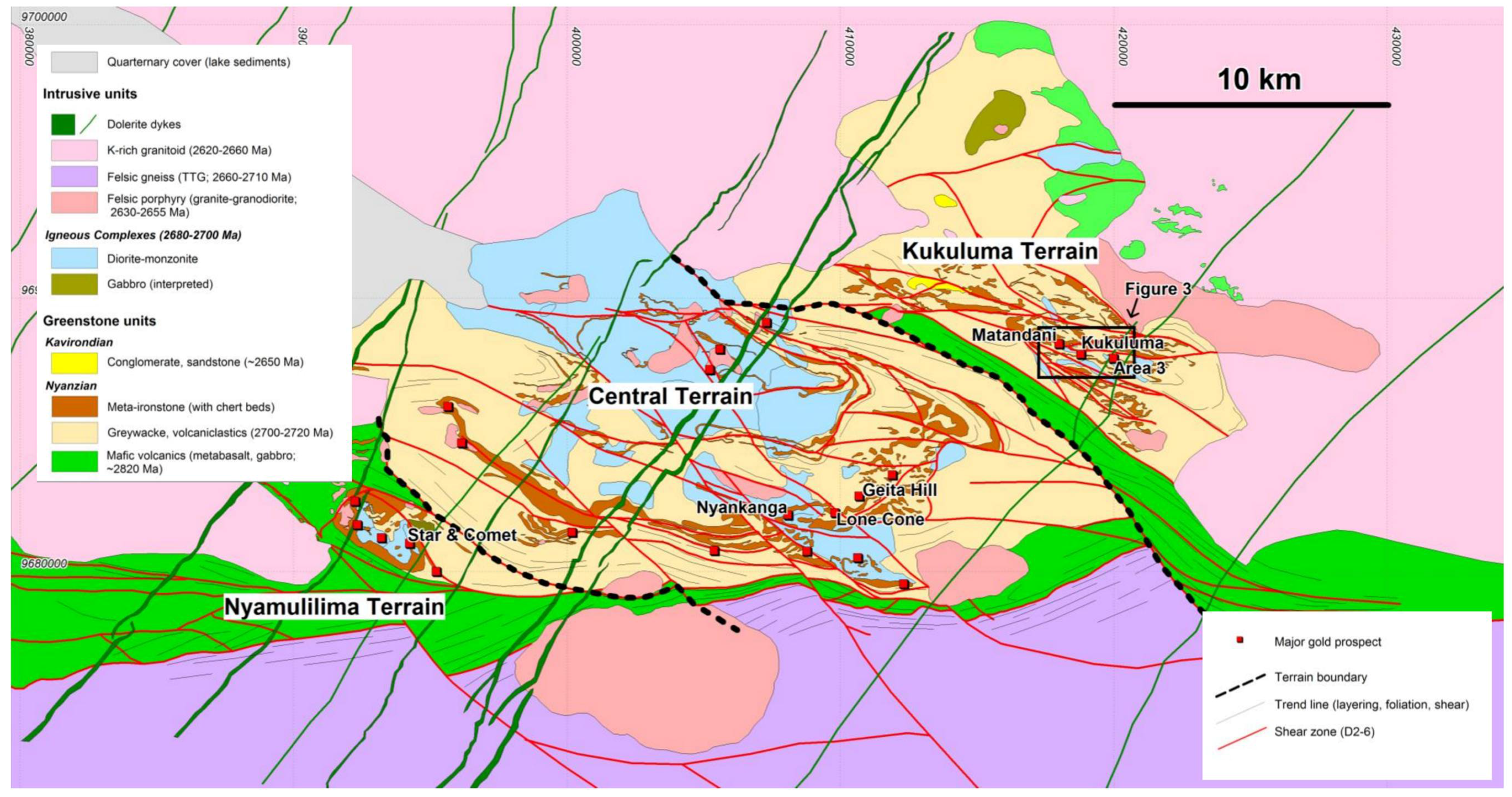
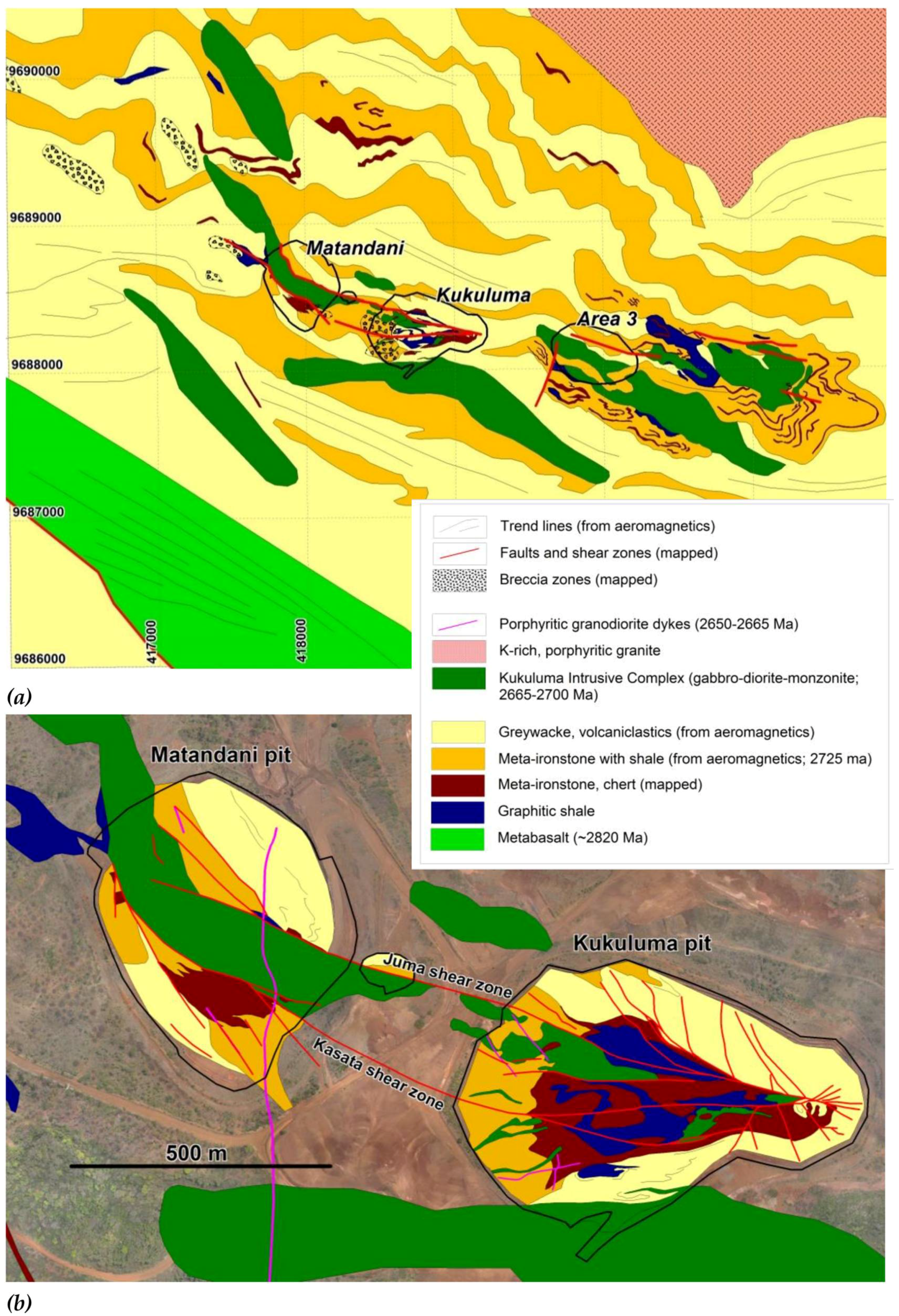

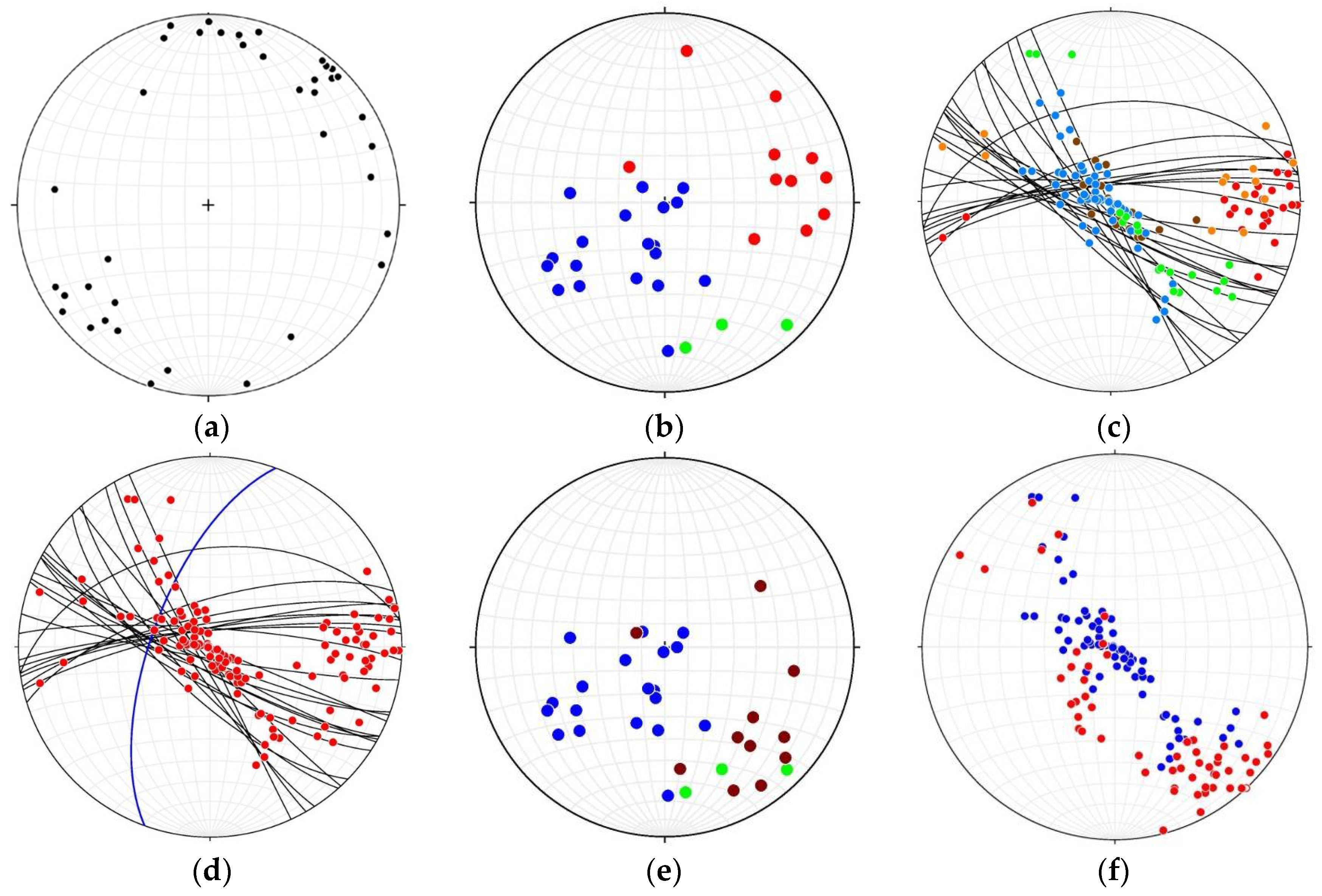
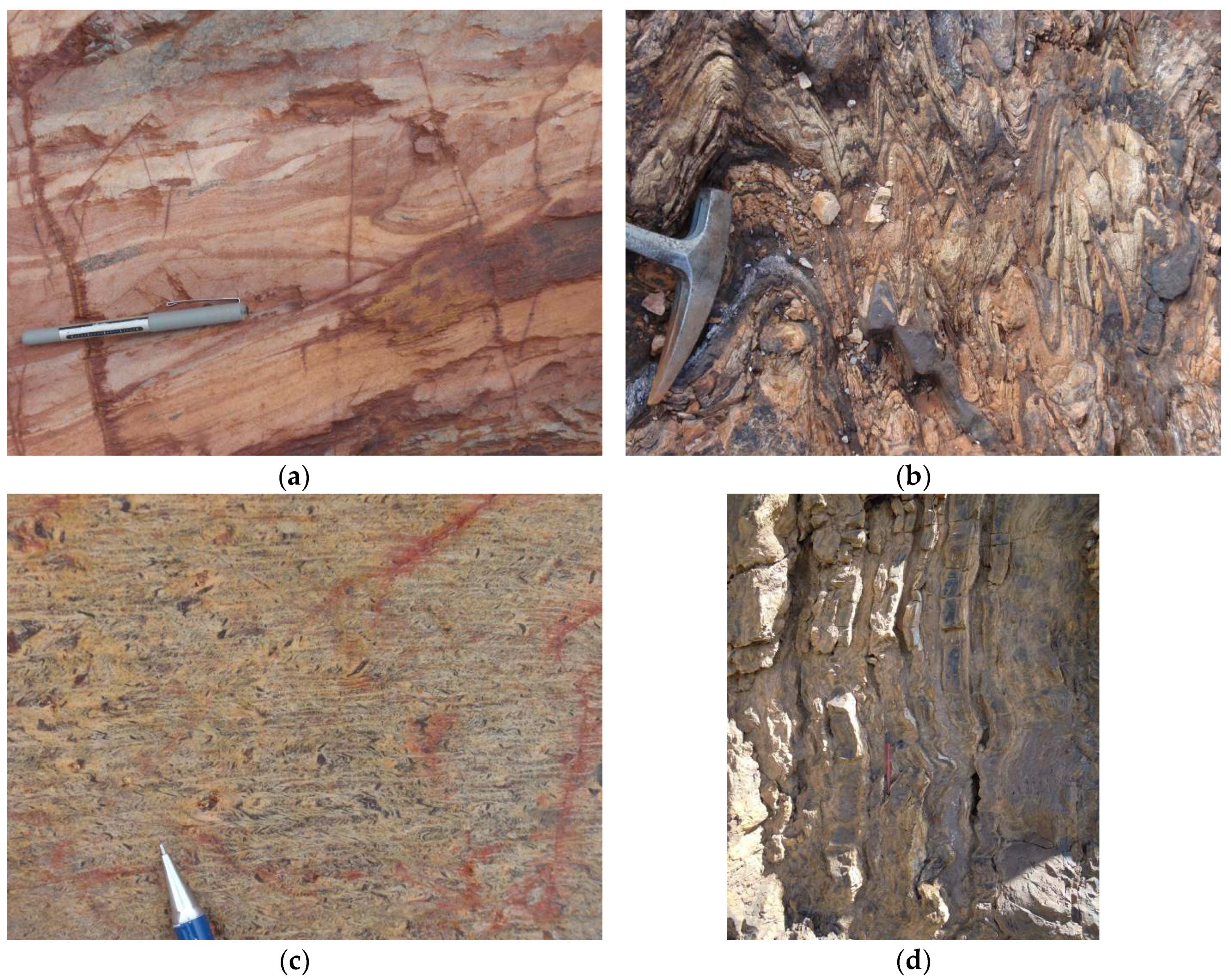





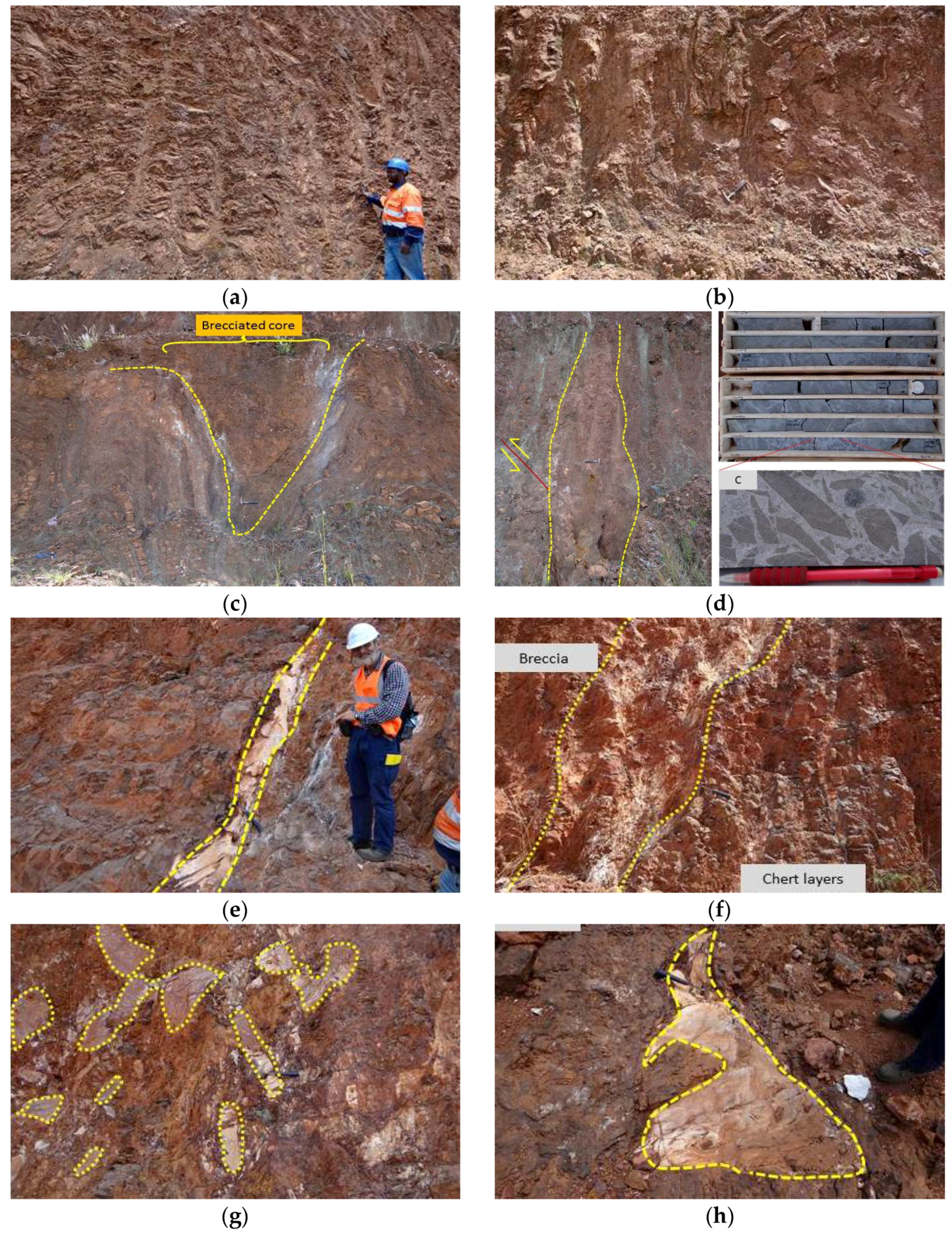

| Deform. Event | Intrusive Event [Age] | Description of Structures | Mineralization [Trapping Structures] |
|---|---|---|---|
| D1 | Volcanism (2715 Ma) | Layer-parallel shears Growth faulting | Mineralisation trapped by Fe-rich lithologies |
| D2 | Start of emplacement of KIC: Gabbro-diorite-monzonite suite (2700–2680 Ma) | Non-cylindrical folding (1–500 m scale) Formation of penetrative S2 fabric Sills, dykes and plugs | Mineralization in F2–F3 fold hinge zones Mineralization along diorite-ironstone contacts |
| D3 | Further emplacement of KIC: Gabbro-diorite-monzonite suite (2700–2680 Ma) | Folding on 1-500 m scale Plunge varies across F2 fold limbs Associated with S3 axial planar cleavage that dips steeply SW High-strain domains bound folded domains Emplacement of KIC along D3 axial planes with S3 fabric in KIC Extensive brecciation of D2–D3 folded ironstone near margins of KIC | Mineralization trapped along F3 fold axial planes characterized by microfracturing Mineralization in breccia zones |
| D4 | Open, cylindrical upright folding Symmetric folds plunge steeply WNW Limited S4 fabric development | ||
| D5 N-S compression | Open cylindrical recumbent folds Low angle reverse faults with small offsets (<10 m) | ||
 | Further emplacement of KIC: Granodiorite suite (2680–2665 Ma) | Felsic porphyry dykes truncate D1–4 folds | |
| D6 N-S compression  | NW to WNW trending, steeply dipping, brittle ductile shear zones. Dextral-reverse Fracture networks overprint F2–F3 folds and breccia zones Associated with tectonic breccia | D6 shear zones and associated damage zones facilitate fluid infiltration and fluid-rock interaction | |
| Emplacement of felsic dykes (2650 Ma) | N trending felsic porphyry dyke | Mineralization overprints dykes | |
| D7 N-S extension | Normal faulting Reactivation of D6 shears as sinistral normal faults | D7 shear zones are mineralized, and acted as the main fluid channel ways apy-po-py ore assemblage | |
 | Granitoids plutons (2620–2640 Ma) | ||
| (a) | |||||||||
| Deposit | grade | Chert | Ironstone | Volc | Seds | Bshale | Diorite | FP | Total |
| Matandani | >0.1 ppm Au (m) | 533.44 | 300.49 | 112.01 | 69.35 | 30.24 | 31.49 | 5.19 | 1082.21 |
| >0.5 ppm Au (m) | 287.65 | 208.38 | 32.76 | 29.04 | 5.45 | 15.60 | 2.54 | 581.42 | |
| >1.0 ppm Au (m) | 193.59 | 174.70 | 20.04 | 18.64 | 1.50 | 15.60 | 0.00 | 424.07 | |
| >5.0 ppm Au (m) | 33.28 | 65.17 | 9.00 | 1.00 | 0.00 | 13.00 | 0.00 | 121.45 | |
| Kukuluma | >0.1 ppm Au (m) | 175.79 | 283.07 | 73.07 | 92.11 | 17.97 | 40.47 | 0.00 | 682.48 |
| >0.5 ppm Au (m) | 111.30 | 111.41 | 16.20 | 52.89 | 4.00 | 8.30 | 0.00 | 304.10 | |
| >1.0 ppm Au (m) | 86.65 | 45.98 | 3.00 | 41.75 | 3.00 | 4.30 | 0.00 | 184.68 | |
| >5.0 ppm Au (m) | 21.00 | 4.45 | 1.00 | 15.98 | 0.00 | 11.00 | 0.00 | 53.43 | |
| Area 3 West | >0.1 ppm Au (m) | 127.75 | 265.34 | 49.86 | 7.00 | 17.35 | 17.00 | 0.00 | 484.30 |
| >0.5 ppm Au (m) | 60.11 | 128.50 | 27.00 | 1.00 | 2.50 | 10.00 | 0.00 | 229.11 | |
| >1.0 ppm Au (m) | 37.36 | 93.34 | 12.70 | 0.00 | 0.00 | 4.00 | 0.00 | 147.40 | |
| >5.0 ppm Au (m) | 10.21 | 28.44 | 2.00 | 0.00 | 0.00 | 2.00 | 0.00 | 42.65 | |
| (b) | |||||||||
| Deposit | grade | Chert | Ironstone | Volc | Seds | Bshale | Diorite | FP | Total |
| Matandani | >0.1 ppm Au (%) | 49.29 | 27.77 | 10.35 | 6.41 | 2.79 | 2.91 | 0.48 | 100.00 |
| >0.5 ppm Au (%) | 49.47 | 35.84 | 5.63 | 4.99 | 0.94 | 2.68 | 0.44 | 100.00 | |
| >1.0 ppm Au (%) | 45.65 | 41.20 | 4.73 | 4.40 | 0.35 | 3.68 | 0.00 | 100.00 | |
| >5.0 ppm Au (%) | 27.40 | 53.66 | 7.41 | 0.82 | 0.00 | 10.70 | 0.00 | 100.00 | |
| Kukuluma | >0.1 ppm Au (%) | 25.76 | 41.48 | 10.71 | 13.50 | 2.63 | 5.93 | 0.00 | 100.00 |
| >0.5 ppm Au (%) | 36.60 | 36.64 | 5.33 | 17.39 | 1.32 | 2.73 | 0.00 | 100.00 | |
| >1.0 ppm Au (%) | 46.92 | 24.90 | 1.62 | 22.61 | 1.62 | 2.33 | 0.00 | 100.00 | |
| >5.0 ppm Au (%) | 39.30 | 8.33 | 1.87 | 29.91 | 0.00 | 20.59 | 0.00 | 100.00 | |
| Area 3 West | >0.1 ppm Au (%) | 26.38 | 54.79 | 10.30 | 1.45 | 3.58 | 3.51 | 0.00 | 100.00 |
| >0.5 ppm Au (%) | 26.24 | 56.09 | 11.78 | 0.44 | 1.09 | 4.36 | 0.00 | 100.00 | |
| >1.0 ppm Au (%) | 25.35 | 63.32 | 8.62 | 0.00 | 0.00 | 2.71 | 0.00 | 100.00 | |
| >5.0 ppm Au (%) | 23.94 | 66.68 | 4.69 | 0.00 | 0.00 | 4.69 | 0.00 | 100.00 | |
© 2018 by the authors. Licensee MDPI, Basel, Switzerland. This article is an open access article distributed under the terms and conditions of the Creative Commons Attribution (CC BY) license (http://creativecommons.org/licenses/by/4.0/).
Share and Cite
Kwelwa, S.D.; Dirks, P.H.G.M.; Sanislav, I.V.; Blenkinsop, T.; Kolling, S.L. Archaean Gold Mineralization in an Extensional Setting: The Structural History of the Kukuluma and Matandani Deposits, Geita Greenstone Belt, Tanzania. Minerals 2018, 8, 171. https://doi.org/10.3390/min8040171
Kwelwa SD, Dirks PHGM, Sanislav IV, Blenkinsop T, Kolling SL. Archaean Gold Mineralization in an Extensional Setting: The Structural History of the Kukuluma and Matandani Deposits, Geita Greenstone Belt, Tanzania. Minerals. 2018; 8(4):171. https://doi.org/10.3390/min8040171
Chicago/Turabian StyleKwelwa, Shimba D., Paulus H. G. M. Dirks, Ioan V. Sanislav, Thomas Blenkinsop, and Sergio L. Kolling. 2018. "Archaean Gold Mineralization in an Extensional Setting: The Structural History of the Kukuluma and Matandani Deposits, Geita Greenstone Belt, Tanzania" Minerals 8, no. 4: 171. https://doi.org/10.3390/min8040171






